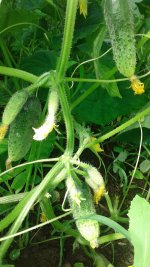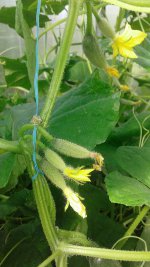Marck
Full Access Member
Those immature seeds do look larger than what I would expect from a seedless cucumber, though possibly they would just remain at that stage of development.
You did mention that one of your plants produced male flowers. Did you try any hand-pollination with those? Even if you did not, perhaps a rare pollination event happened. This might suggest that pollination would be a more successful route than parthenocarpy, but one odd cucumber doesn't prove much either way.
Parthenocarpic cucumbers are F2 hybrids that must be especially cross-bred every year. Perhaps, some percentage of the F2 offspring do not completely inherit the parthenocarpy trait. I have read that some will still produce about 10% male flowers, though that may vary with cultivar. I have also read that the pollen will be sterile, but this doesn't seem to always be the case.
Your idea that you were sent the wrong seed may be the case. Next year try seed from a different supplier. Also grow more than two plants to the flowering stage if possible. Even if you have to cull some of them later, you may get a larger array of specimens to choose from.
You did mention that one of your plants produced male flowers. Did you try any hand-pollination with those? Even if you did not, perhaps a rare pollination event happened. This might suggest that pollination would be a more successful route than parthenocarpy, but one odd cucumber doesn't prove much either way.
Parthenocarpic cucumbers are F2 hybrids that must be especially cross-bred every year. Perhaps, some percentage of the F2 offspring do not completely inherit the parthenocarpy trait. I have read that some will still produce about 10% male flowers, though that may vary with cultivar. I have also read that the pollen will be sterile, but this doesn't seem to always be the case.
Your idea that you were sent the wrong seed may be the case. Next year try seed from a different supplier. Also grow more than two plants to the flowering stage if possible. Even if you have to cull some of them later, you may get a larger array of specimens to choose from.





